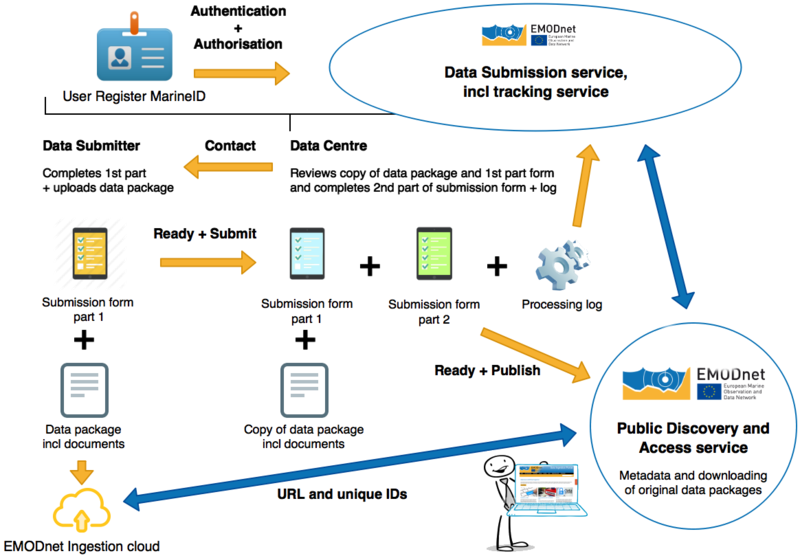How to submit
The Data Submission service facilitates organisations managing marine datasets to submit marine datasets of relevance for bathymetry, geology, chemistry, physics, biology and human activities for the European marine waters and coastal zones.
Note: Data submitters have to register in the Marine-ID register to get an account in the Data Submission service.
You can download the Manual for Data Submitters and the Manual for Data Centres.
To make the threshold for submission relatively low the completion of the submission form has been divided over the data submitter (part 1) and the data centre (part 2) that will be assigned to process the submission.
- Part 1 submission form: a number of key metadata fields to be completed by the data submitter, including uploading of a zip file with the datasets and related documentation;
- Part 2 submission form: a number of additional metadata fields to be completed by the assigned data centre, while reviewing the received datasets package and part 1 metadata and possibly in contact with the data submitter.
The workflow process is illustrated below:

As data submitter you are asked to complete part 1 of a submission form with a number of key metadata and to upload your datasets as a zip package. Please include also relevant documentation by means of reports on the in-situ observation activity, possibly applied quality assurance, specification of formats (data and metadata), because that will make it easier for the data centres to review and work up your submission for publishing.
A data tracking service is integrated in the Data Submission service to allow data providers to stay informed about the progress from data submission to publishing.
A number of important tips:
- The submission should concern datasets for observations and/or analysed samples together with documentation and not just stand-alone reports. Furthermore, you are encouraged to submit data packages which rather concern collections of datasets, for example resulting from a project, cruise, monitoring programme etc., and not individual datasets. Do not forget to include relevant documentation too in the zip package that you submit.
- You are advised not to upload too large data collections per data package because of upload performances, but also to restrict having too many different data sets in a data package. Therefore, you might divide data packages at least by theme and possibly by observation methods in order to get smaller and more harmonised data packages. This implicates that you should build series of data packages for specific projects which will be beneficial for the further processing and uptake in data repositories.
- Most submission metadata fields are supported by SeaDataNet controlled vocabularies while allowing also free text entries. In those cases you are urged to use existing terms and only to enter free text if you cannot find the relevant terms.
- The assigned data centre will review and curate your data submission in order to make these fit for long term storage and stewardship in their data management system and to share it with the appropriate EMODnet Data portal. However there is a great variety of data types and formats around and as demonstrated in the regular practice of the data centres, it can take significant human efforts and time for processing, validating, converting and documenting of incoming data sets with the aim to make these part of their data management systems. To ease and accelerate this process you are encouraged to adopt common formats for metadata and data for the submitted datasets. Guidance information can be found here.
Note: Details about the submission workflow and the metadata elements of the submission form can be found in the Data Submission form elements document.
